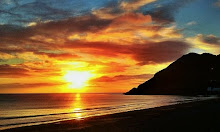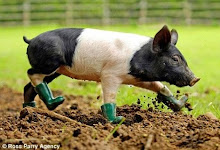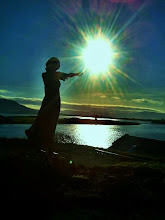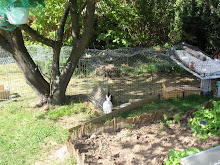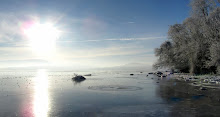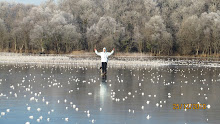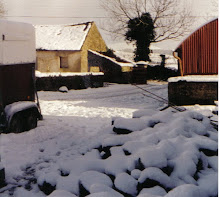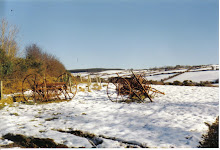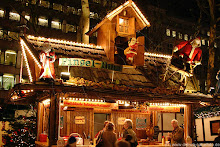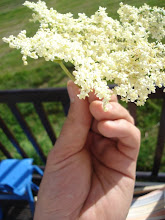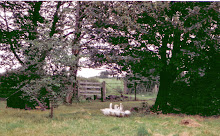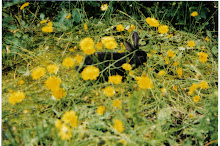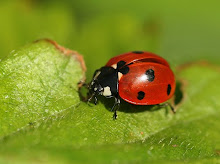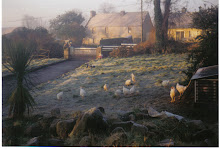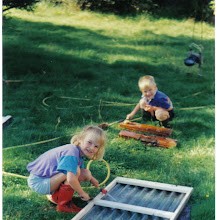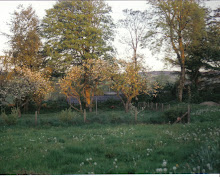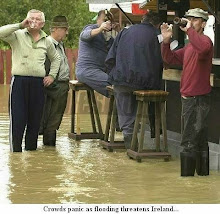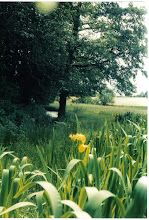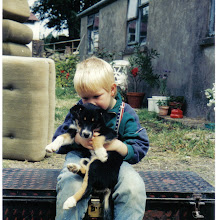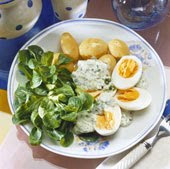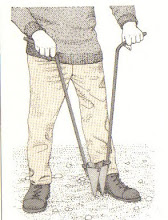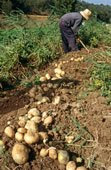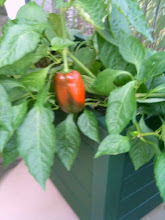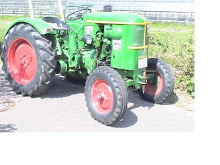It's been 2 weeks now since disaster struck Japan. Every day, American news media report in their typical over the top sensational manner about what might happen, could have happened...and do we really know what happened? Is nuclear technology any safer now than 25 years ago. How can it ever be?
The beginning of my blog www.Ioncehadafarminireland.blogspot.com takes me right back and is eerily familiar:
"It was the environmental disaster of Chernobyl in 1986, and the overall nuclear threat that motivated us enough to opt out of the rat race and start afresh in Ireland. After Chernobyl, in Germany fall out levels were dangerously high. The government discouraged people to feed milk to their children, not to eat fresh vegetables --and this was early summer- and our new Geiger counter measured excessive radiation levels in our children’s sandbox. Ireland had escaped almost unscathed due to the prevailing weather pattern in the 2 weeks after the disaster in Ukraine."
Radiation was measured yesterday in Hawaii, the West coast, even in Colorado. Depending on prevailing weather patterns - that merry-go-round of thermodynamics and the big unknown that weathermen never seem to get right- the whole world might be in for a few u-turns and imponderables, unforeseeables, and God forbid the unexpected. Imports from Japan have been banned widely. But what do the poor Japanese do?
After Chernobyl,we went to a country that was minimally affected to grow our own healthy food. Twenty-five years later, a massive new scare. BTW, do you know the half-life of Plutonium or Cesium? Surprise, surprise, remnants are still lingering in Ukraine. Regions unfit to live in for thousands of years--except for those unfortunate who cannot leave the area and have to stay put. They still suffer the horrible consequences. European Journal, a show broadcast from Germany on PBS -thank God for public radio and TV- reported about big nuclear accident before Chernobyl, an event even I had never heard about: MAYAK, 50 years ago. Guess what: People there and their children and children's children are still exposed to the radiation caused then and suffer from horrific congenital diseases. Because the half-life of Plutonium 239 is 24,000 years! Geiger counters still go crazy in that area. If the Mayak area has a hot summer again, people will swim in the Techa River yet again and soak it right in.
So what can a single person do who wants to let his species survive? Or an organic farmer? "Even if I knew the world came to an end tomorrow, I would still plant an apple tree today." (Martin Luther)
Saturday, March 26, 2011
Thursday, March 17, 2011
Happy St. Patricks Day
Even if you don't dye rivers green in Ireland- you might just be painting the town red- happy Paddy's day on both sides of the Atlantic. Seize the Day! Nil Se'n La! Wishing you lots of luck!
The world needs it and can do with it big time. All our joint organic efforts may become null when our environment ceases to exist the way we know it. It reminds me of our Chernobyl experience that I describe at the beginning of this blog www.Ioncehadafarminireland.blogspot.com. It was the reason for us to take our family to a safer country. But where is safe, ultimately.
Here is the link to the well-informed article of a German scientist friend, Stefan Thiesen, (earth and sea)
http://www.opednews.com/articles/Michio-Kaku--We-live-in-a-by-Stefan-Thiesen-110317-693.html. We all live in a bubble. Think about it!
Or go to the Celtic Women and enjoy their music: http://www.somemusicecards.com/celtic-woman/share/?ec=a6e77217d803b881f2b6ee3d316f5869
Beannachtam na Feile Padraig! May you be poor in misfortune, and rich in blessings, slow to make enemies and quick to make friends. And may you know nothing but happiness from this from this day to life's end. Sl'n agus beannach!
The world needs it and can do with it big time. All our joint organic efforts may become null when our environment ceases to exist the way we know it. It reminds me of our Chernobyl experience that I describe at the beginning of this blog www.Ioncehadafarminireland.blogspot.com. It was the reason for us to take our family to a safer country. But where is safe, ultimately.
Here is the link to the well-informed article of a German scientist friend, Stefan Thiesen, (earth and sea)
http://www.opednews.com/articles/Michio-Kaku--We-live-in-a-by-Stefan-Thiesen-110317-693.html. We all live in a bubble. Think about it!
Or go to the Celtic Women and enjoy their music: http://www.somemusicecards.com/celtic-woman/share/?ec=a6e77217d803b881f2b6ee3d316f5869
Beannachtam na Feile Padraig! May you be poor in misfortune, and rich in blessings, slow to make enemies and quick to make friends. And may you know nothing but happiness from this from this day to life's end. Sl'n agus beannach!
Tuesday, March 15, 2011
A typical day
Get up at 6 a.m. Make breakfast. Let out the geese and chickens as soon as the sun is out. Wake children. Grind wheat into flower in the pantry. 1kg takes about 45 minutes. Have breakfast. Start baking bread or cake while children get dressed and pack their bags. Prepare lunch boxes. Let bread rise and put in the hot AGA for an hour. (Mac would take it out when finished; usually during 'elevenses'- his coffee break in the morning).Mac would go out and check on animals if there were any in the stables. Together with the children, he would feed horses and muck out. Children feed dogs and cats. I shower and get dressed. Pack my books and get ready, equipped with shopping list. Get kids in the car. In the first years, drive kids to local school, later to the one in Limerick (45 min). Go to work: teach a few hours at the University while Mac ran the farm; pick up children, grab some groceries with tired children in the car. Time for coffee and cake break while kids do their homework. Mac would go to do his errands as car was back or all three would exercise the horses and I cook dinner. Prepare classes for next day or do some gardening. Then the stables had to be mucked out again, animals fed and put to bed. Time for a book or paper. Then crash exhausted.
Wednesday, March 2, 2011
Never a dull moment
Early in the year, Mac revealed that he wanted to take over more of the acres which so far had been rented out to two neighbors. "What for?" "More sheep, some cattle, and then we need grass for them, of course. Grazing ground". Instead of self-sufficiency, which had been our only goal so far, he had decided to extend his farming and husbandry activities. I had been quite contented with the extent of our gardening activities , i.e. grow our own and maybe sell some surplus. But being the economist that he was, Mac was hatching plans in his head of how to make the enterprise commercially viable. We were a long away from it, however. I had learned the term "gentleman farming" and it had appealed to me. The rent from the land secured a steady income and left time for what we originally had also planned, i.e., playing golf,fishing or go sailing occasionally. With 20 new ewes and ca. the same amount of young heifers the chances of that seemed to dwindle.
In the meantime, before more sowing and planting could be done because of inclement weather, these new fields had to be prepared: The removal of weeds, (with the tractor or manually of course the old fashioned way without Roundup); fertilizing the land with manure and overall a fair amount of fencing needed to be done. Winter time is the preferred time for fencing, unless there is an urgent necessity. Then fencing always takes priority over other things, particularly plans one had been looking for. The Farmers' Journal was the source for finding livestock unless the neighbor knew somebody who wanted to sell certain things we were looking for. Also the place to advertise hay or the AGA (see previous stories).
A farmer must have coined the saying which became our mantra: never a dull moment. But for Mac it was all play, his hobby. He loved every minute of it.
In the meantime, before more sowing and planting could be done because of inclement weather, these new fields had to be prepared: The removal of weeds, (with the tractor or manually of course the old fashioned way without Roundup); fertilizing the land with manure and overall a fair amount of fencing needed to be done. Winter time is the preferred time for fencing, unless there is an urgent necessity. Then fencing always takes priority over other things, particularly plans one had been looking for. The Farmers' Journal was the source for finding livestock unless the neighbor knew somebody who wanted to sell certain things we were looking for. Also the place to advertise hay or the AGA (see previous stories).
A farmer must have coined the saying which became our mantra: never a dull moment. But for Mac it was all play, his hobby. He loved every minute of it.
Subscribe to:
Posts (Atom)
